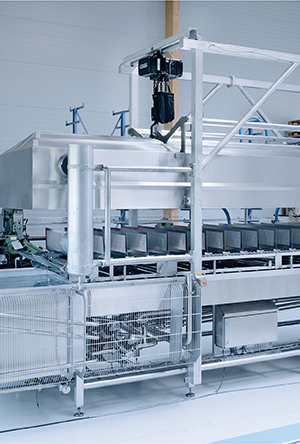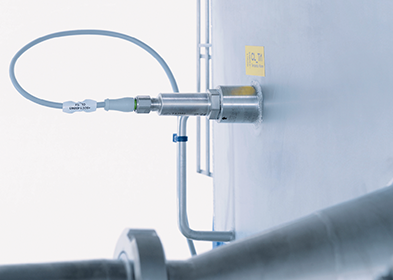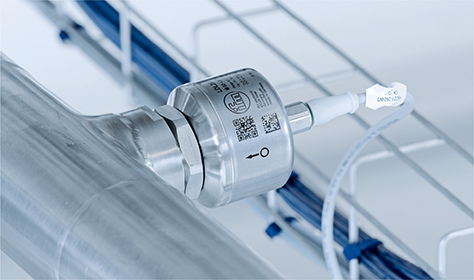

Cook the dough in hot water, drain and refresh with cold water, ready to serve. The pasta cooker from Staedler Automation uses the same method we all know from home, but on an industrial scale, accurately controlled using sensors from ifm electronic to ensure product quality remains at a high level. Among other things, Staedler produces fully automated cooking systems for the food industry. The system illustrated in this article is for a customer that makes spaetzle, a type of German pasta.
Lukas Staedler, CEO of Staedler Automation, explains how the system works: “You have to imagine a saucepan that is continually on the go. This means the fresh dough is loaded at the beginning of the cooking line and is passed through during a defined period so that at the end you have a product which is cooked to the right degree. Using a defined cooking time we ensure constant product quality.”
The foodstuff being cooked is transferred to hot water using a paddle. At the end of the cooking process, the product is quickly transferred over a waterfall edge to the cooling zone. This blanching with cold water stops the product from cooking any further.
“In principle, systems like this can cook anything that floats,” emphasises Staedler. “In this specific line, we process fresh pasta such as ravioli, tortellini or in this case spaetzle. But it could also be cold meats or vegetables. This system reaches a product output of 2,5 tons per hour.”
Maintaining the exact temperature
When we cook pasta at home and see the water starts to boil we know this is the right temperature. However, in industrial cooking processes the temperatures used have to be more accurately measured to provide constant product quality.
In this system, the temperature is measured at two points providing the critical control points (CCP). One is the temperature of water which is nearly boiling. In this case it has to be exactly 95°C. The other is the temperature of the cooling bath where the cooking process is stopped. Two temperature sensors control the heat exchanger ensuring exact temperatures.

For these critical points Staedler relies on temperature sensors type TA2502 from ifm. These sensors have a highly-accurate, fast-response Pt1000 measuring element, covering a temperature range of -50°C to 200°C. Also the sensors have a high repeatability and long-time stability, which are prerequisites for optimum and repeatable product quality.
In the future, Staedler plans to use the self-monitoring temperature sensor type TCC from ifm to monitor these points. This has two independent measuring elements with opposing temperature characteristics that counteract each other. Deviations in accuracy are thus recognised immediately and signalled by alarm switching signals. They are also clearly visualised via an LED directly on the unit.
Monitoring clean-in-place (CIP) processes
After each production charge, the system undergoes a CIP cycle. A pump is used to rinse the product lines with alkaline and acidic cleaning agents. They are then rinsed with clear water before production is restarted. During this process, the ifm conductivity sensor LDL200 plays an important role. Based on precisely measured conductivity, it is possible to confirm if the line contains cleaning agent residue and at what concentration.
According to the measurement values, the control system recognises, for example, if further cleaning agents are to be added, or if the pre, intermediate and final rinsing have all taken place. The final stage of the cleaning process is rinsing with clear water. Only when the exact conductivity of the final rinsing water is reached, is the system then released for production. This ensures adequate hygiene standards are achieved during the CIP cycle.
Water level and supply
The cooking system has two large water tanks: the bath with the hot water and the cooling bath at the end of the process. Pressure sensors installed at the bottom of each tank measure the hydrostatic pressure. The ifm sensors which are used have a pressure range of 100 mbar to 2,5 bar. They determine the exact level and are used to regulate it to avoid tank overflow or under-fill.

Since water is lost during the cooking process, due to evaporation and the spaetzle absorbing water, it has to be continuously added. “We use the SM2100 magnetic flowmeter from ifm to regulate the replenishment of fresh water,” explains Staedler. “It continuously measures the flow during the cooking process, in conjunction with the level sensors. When the level of the water decreases, fresh water is added and the flowmeter determines the amount to ensure the integrity of the cooking process. The flowmeter is also used during the cleaning process to monitor the quantity of fresh water used for rinsing.”
Position monitoring with inductive sensors
Inductive sensors for position detection are also installed. Even though they do not play a direct part in the cooking process, they have an important monitoring function. The cooling band, used to transfer cooked product to and from the cooling bath, can be lifted and manually cleaned. Two inductive sensors are used for non-contact detection of the top and bottom positions. They also ensure that the system can only be restarted if the band is in the correct lower position.
A third inductive sensor monitors the slot screen, which can also be removed for manual cleaning. The sensor checks for its correct fitment before production is resumed.
Sensor communication using IO-Link
All sensors are connected to the control system via IO-Link, which transfers the measured values to the control system in digital form. However, IO-Link can do more, as Staedler explains: “Each CCP sensor has to be checked on an annual basis. The temperature sensors are placed in a reference temperature liquid and calibrated. We calibrate temperature sensors using IO-Link. Also, in the case of the conductivity sensor, we are able to get both temperature and conductivity values over a single wire, while the flowmeter transfers the counter values as well as the current flow velocity over one output.”
Conclusion
Staedler is convinced by the automation solutions provided by ifm. He summarises as follows: “We are extremely satisfied with the solutions from ifm electronic. The reason being that as a sensor company, ifm has a comprehensive concept across the ranges of inductive sensors, magnetic flowmeters, temperature sensors and pressure sensors, all the way through to conductivity measurement. In short, we can cover all our system needs with ifm sensors. A further reason is that the price-performance ratio is right. The sensors make sense for this type of system and are also affordable. We will definitely use ifm products for future projects.”

© Technews Publishing (Pty) Ltd | All Rights Reserved